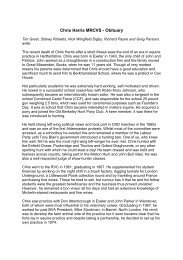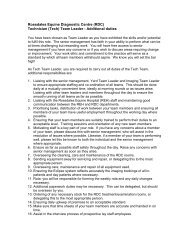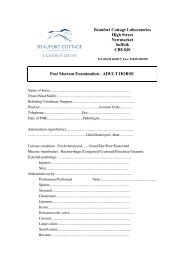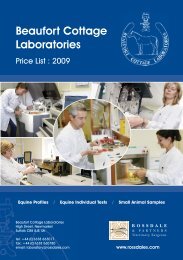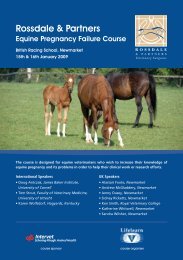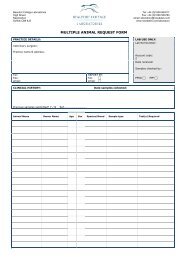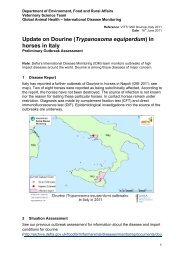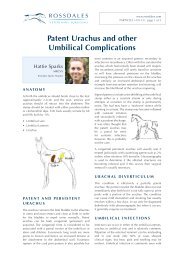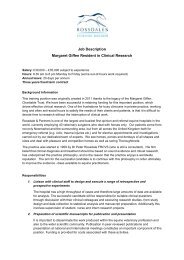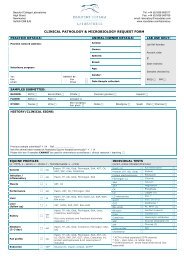EQUINE CLINICAL PATHOLOGY - Rossdale & Partners
EQUINE CLINICAL PATHOLOGY - Rossdale & Partners
EQUINE CLINICAL PATHOLOGY - Rossdale & Partners
You also want an ePaper? Increase the reach of your titles
YUMPU automatically turns print PDFs into web optimized ePapers that Google loves.
G u i d e t o e q u i n e c l i n i c a l p a t h o l o g y<br />
Fig.7: serum protein electrophoresis<br />
fibrinogen spike in heparinised plasma<br />
Test : ELECTR Gel 2 – 5 16/05/2002<br />
Fig.8: serum protein electrophoresis<br />
monoclonal beta 2 globulin 'sky rocket'<br />
Test : ELECTR Gel 1 – 8 30/05/2002<br />
Fraction Rel% G/L<br />
1 5.4 2.48<br />
2 19.8 9.11<br />
3 17.5 8.05<br />
4 36.0 16.56<br />
5 21.3 9.8<br />
Total G/L 46.00<br />
Serum Immunoglobulin G (IgG)<br />
As there is no transplacental transfer of<br />
IgG before birth, foals are born essentially<br />
agammaglobulinaemic. During the last few<br />
months of gestation, mares concentrate<br />
IgG in their colostrum. Foals’ intestines are<br />
capable of absorbing IgG for their first 12<br />
hours of life. Providing the mare makes<br />
colostrum of good quality in terms of IgG<br />
concentration, she does not ‘run milk’<br />
before foaling and the foal sucks sufficient<br />
colostrum within the first 12 hours, the foal<br />
acquires good circulating IgG levels and<br />
therefore adequate passive immunity.<br />
Foals should have their serum IgG levels<br />
checked as a routine preventive medicine<br />
policy. Serum samples collected from foals<br />
after 12 hours of age should have IgG<br />
levels of more than 4 g/l and ideally more<br />
than 6 g/l. Levels of less than 2 g/l indicate<br />
failure of transfer of colostral immunity and<br />
levels of 2-4 g/l indicate partial failure.<br />
Fraction Rel% G/L<br />
1 2.1 1.91<br />
2 9.5 8.65<br />
3 9.5 8.65<br />
4 71.2 64.79<br />
5 7.6 6.92<br />
Total G/L 91.00<br />
Foals with levels below 4 g/l are considered<br />
at risk for neonatal infections and should be<br />
transfused with hyperimmune plasma and<br />
their serum IgG levels re-checked 24 hours<br />
later to make sure that IgG levels have risen<br />
to acceptable levels.<br />
Our experience suggests that none of the<br />
currently available ‘stable-side’ foal serum<br />
IgG tests are reliably accurate at the 0-4 g/l<br />
end of the scale and we measure IgG by an<br />
immunospectrophotometric method run on<br />
our autoanalyser.<br />
IgG can be measured in colostrum<br />
immediately after parturition semiquantitatively,<br />
using a refractometer<br />
(Colostrometer) (see table on page 22). If<br />
readings suggest an IgG level of less than<br />
45 g/l, the foal should be considered for<br />
donor colostrum supplementation by bottle<br />
or stomach tube.<br />
21



